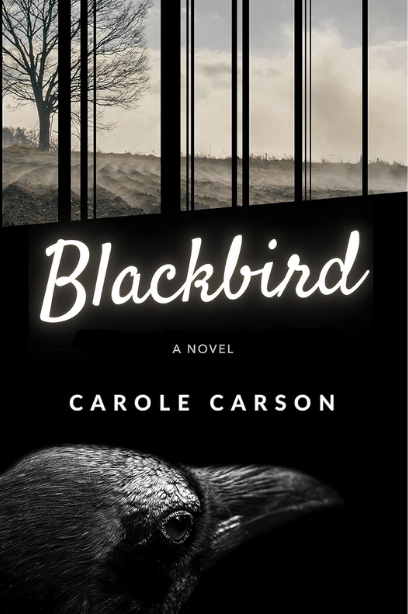Issue Archive
Book Review: Blackbird: A Novel

By Carol Carson
2023
Hound Press. ISBN: 979-8-9869933-0-0
At the outset, let me say unequivocally that Blackbird is a page turner. It is the riveting story of a child, Jane, who endures horrendous abuse. It is categorized as fiction, although Carole Carson acknowledges in her Author’s Note it is about her life — with liberties taken for the purpose of revealing what she calls emotional truths. Is it a memoir? Is it autofiction? Whatever its classification, the book has a visceral impact on the reader and reveals the potentially deadly effects of repeated trauma.
The title of the book, Blackbird, can be taken as metaphoric. In one harrowing scene a blackbird is caught in freshly poured concrete. The image of the trapped bird (who will surely die) haunts her. Jane is unable to free it. This could be symbolic of her own predicament. She is a child who cannot escape from the barbaric treatment of her parents.
This is first in a series of four books about the fictional Jane Bertram’s life. Set in the Midwest at the start of WWII, this volume follows Jane from preschooler to young adult in the 1960’s. The family barely gets by. Jobs are scarce, aspirations low, opportunities are greatly circumscribed, and resentment is in abundance. Leroy, Jane’s father, constantly scheming unsuccessfully to make a quick profit, is away from the family for weeks at a time leaving his wife, Gladys, to look after the household and their five children. She hates her predicament and their relationship is fraught.
I found myself wanting to get past the opening chapters because they depicted a life so awful it was painful to read. This is not hyperbole. When we first meet her, Jane is a four-year-old. She is frequently charged with looking after her younger sister, Ginny. Although innocent, Jane is nevertheless blamed whenever Ginny suffers a mishap. She is regularly verbally berated and subjected to vicious corporal punishment by her mother and is constantly accused of lying. Here is an example of how the book grabs you immediately and sets the tone for what follows.
“I’m not picking you up. You need to stay where you are.” Gladys grabbed the heavy basket of wet laundry. “Keep an eye on her, Gladys said to Jane. The kitchen door slammed behind her.
Seeing her mother leave made Ginny howl even louder.
Jane picked up a stuffed rabbit that Ginny had managed to
toss halfway under the kitchen chair.
“Look, Ginny! Here’s Mr. Rabbit. Hippity-hoppity, hippity-hoppity” She handed the stuffed toy to Ginny. “You love Mr. Rabbit.”
Ginny grabbed the ears of the rabbit and tossed the toy back onto the floor. Jane picked up the rabbit and offered it again. Ginny tossed it on the floor again. She held up her arms.
“You want out, don’t you? That’s what you want. I’ll help you out,” Jane offered.
She tried to lift Ginny out of the playpen, but her baby sister was too heavy. They both came crashing down on the kitchen floor. Jane landed on top of Ginny, whose arm was bent behind her.
Ginny started screaming.
Gladys rushed back into the house.
“What were you doing.” she asked. “Why’s she bawling?”
“I tried to help her get out.” Jane backed away from Gladys. Gladys grabbed Jane by the arm and slapped her on the face.
“You leave your sister alone, do you hear?”
“I didn’t do anything.”
“Don’t you lie to me” Gladys picked up Ginny and put her back in the playpen. Ginny let out a loud wail as Gladys turned back to Jane.
“She wanted out.”
Gladys grabbed Jane by the arm and marched her to the kitchen. The pan of water on the stove had reached a boil. She picked Jane up and held her over the steaming water.
Ginny’s wail grew louder.
“I’m sick of your lies. Tell me you hurt her, or I’ll put your hand in this water.”
“I didn’t mean to hurt her” Jane whimpered.
“Stop lying!” Gladys yelled. She grabbed Jan’s wrist and held it over the pot.
“Not lying.” Tears were starting to form.
“You’ll tell me the truth if I have to force it out of you.” Gladys pushed Jane’s hand into the boiling water.
Jane screamed. Ginny let out a companion howl.
Pulling Jane’s red hand out, Gladys asked, “Now will you tell me what you were doing to Ginny?”
Between sobs, Jane shook her head. “I was playing with Mr. Rabbit. She wanted out.”
“Get into your room,” Gladys ordered, putting her down on the kitchen floor. “And stay there. I’ll tell you when you can come out.” (pp. 2-3)
This is only one of numerous sadistic punishments inflicted by her mother with switches, wooden boards, broom handles, and whatever other objects might be nearby. A far cry from Winnicott’s “good enough mother.”
Jane has an older brother, two older sisters, and the younger sister Ginny, but she is singled out for the worst treatment by their mother who views Jane as an embodiment of her husband toward whom she harbors deep animosity and resentment, hence her displaced rage directed at Jane. The older siblings leave home at their earliest opportunity.
The book comprises numerous elements therapists encounter in their work with children. In Jane’s case, we see extreme Adverse Childhood Experience (ACE); i.e., unspeakable brutality, neglect, emotional abuse, humiliation, and abandonment.
These result in feelings of guilt and self-doubt throughout her formative years: she has repeated suicidal ideation and makes several suicide attempts. Her introjection of her
mother’s negative opinions has Jane questioning her worth and believing she deserves the abuse. When, as a teenager, she hits her mother while defending herself against another violent attack, she thinks, “What sort of evil person would strike her own mother?” (p. 118)
As a small child she attempts to cope by having an imaginary companion. Later, she fantasizes running away. At other times, she dissociates, which is common in the cases we see in therapy.
When she eventually leaves her childhood home, her life is not without its challenges. Gladys is constantly in her head. Tragically, Jane doesn’t give up the hope of someday earning her love and approval. Like many children of abuse, she hungers for a gentle loving touch, a word of endearment, a tender embrace. At college, she participates in risky behaviors, exercises questionable judgment, and engages in reenactments typical of patients who have experienced childhood trauma. The men to whom she gravitates initially hold out the promise of a caring relationship but inevitably end up hurting and exploiting her. Dealing with such repetitions is at the heart of our therapeutic work.
There are many missteps. Outcomes are not always good. To reveal more would diminish the suspense. Suffice to say there is much gut-wrenching anguish.
Stylistically, unlike many contemporary novels that switch from present to past and back, Blackbird is linear. We follow Jane through stages in her life seamlessly. It works. The pace of the book is brisk. There is no padding, no precious phrases, no flowery descriptions. Dialogues carry the narrative, and italics reveal Jane’s inner thoughts.
One minor cavil: at times the setups are predictable and contrived. We can see the catastrophe from a mile away. Nonetheless, it is compelling. Like Jane, we are always hoping that this time there will be a happy outcome!
Perhaps circumstances will not be as bleak during the next segments of her life in this tetralogy because we know that Jane’s creator (and non-fiction alter ego), Carole Carson, achieved noteworthy success in several fields, and has continued to reinvent herself. Now, in her 80’s, she relocated to France and has a new career as an author. (Unlike the doomed metaphoric blackbird, she gained her freedom.)
Finally, I believe Blackbird is a book for all readers. The general audience will be rewarded by an engrossing often agonizing story. It is suspenseful and has the elements of a thriller.
The novel can serve as a valuable resource for beginning practitioners. A novice therapist is privy to an abused child’s feelings, perceptions, and rationalizations. This can be helpful as they begin to treat patients who have suffered from abuse at the hands of a parent.
Experienced clinicians who work with trauma can take solace in knowing that adversity is not destiny. When the work is overwhelming, feels as though it is in vain, and you are beleaguered by the torments reported by your patients, Jane’s story will serve as reminder that you can make a difference. Our patients benefit from an attachment to a caring person. It is a connection that can save a life.
Reviewer:

Lawrence Balter is Professor Emeritus at New York University where he taught developmental psychology, child psychopathology, and psychotherapy, and received a Professor of the Year award. He holds a Certificate in Psychotherapy and Psychoanalysis from NYU’s Postdoctoral Program and maintained a clinical practice in Manhattan. He served as a member of the New York State Citizens Task Force on Child Abuse and Neglect. An internationally renowned parenting expert, Balter has appeared extensively in the electronic media and has published numerous books for parents and children. He edited the encyclopedia, Parenthood in America, and co-edited with Tamis-LeMonda, Child Psychology: A Handbook of Contemporary Issues. He is a Consulting Editor at NAEYC’s Young Children. Greater detail is available on Linkedin.
